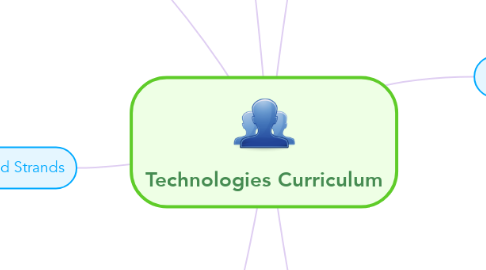
1. Curriculum Aims
1.1. produce designed solutions suitable
1.2. understand roles and responsibilities
1.3. use computational thinking and key concepts
1.4. confidently use digital systems
1.5. apply systems thinking to monitor, analyse, predict and shape the interactions
2. Content Structure and Strands
2.1. Design and Technologies
2.1.1. Knowledge and Understanding
2.1.1.1. TECHNOLOGIES AND SOCIETY
2.1.1.2. TECHNOLOGIES CONTEXTS
2.1.1.2.1. Materials and technologies specialisations
2.1.1.2.2. Food and fibre production
2.1.1.2.3. Engineering principles and systems
2.1.2. Processes and Production skills
2.1.2.1. CREATING SOLUTIONS BY:
2.1.2.1.1. Collaborating and managing
2.1.2.1.2. Investigating and defining
2.1.2.1.3. Designing
2.1.2.1.4. Producing and implementing
2.1.2.1.5. Evaluating
2.2. Digital Technologies
2.2.1. Knowledge and Understanding
2.2.1.1. DIGITAL SYSTEMS
2.2.1.2. REPRESENTATION OF DATA
2.2.2. Processes and Production skills
2.2.2.1. COLLECTING, MANAGING AND ANALYSING DATA
2.2.2.2. DIGITAL IMPLEMENTATION
2.2.2.3. CREATING SOLUTIONS BY:
2.2.2.3.1. Investigating and defining
2.2.2.3.2. Designing
2.2.2.3.3. Producing and implementing
2.2.2.3.4. Evaluating
2.2.2.3.5. Collaborating and managing
3. General Capabilities
3.1. Literacy
3.2. Numeracy
3.3. ICT
3.4. Critical and Creative Thinking
3.5. Personal and Social Capabilites
3.6. Ethical Understandings
3.7. Intercultural Understanding
4. Key Ideas
4.1. Creating prefered futures
4.2. project management
4.3. thinking in technologies
4.3.1. systems thinking
4.3.2. design thinking
4.3.3. computational thinking
4.4. Information and communication technology in the Australian Curriculum
4.4.1. saftey
4.4.2. animal ethics
5. Student diversity
5.1. Support is given for those students with learning difficulties and disabilities, those who are ESL (English as a second language), and those who are gifted and talented.
6. Cross-Curriculum Priorities
6.1. Aboriginal and Torres Strait Islander histories and cultures
6.2. Asia and Australia's engagement with Asia
6.3. Sustainabiility
7. Band Level Descriptors
7.1. Foundation to Year 2
7.1.1. Digital Technologies
7.1.1.1. By the end of Year 2, students will have had opportunities to create a range of digital solutions through guided play and integrated learning, such as using robotic toys to navigate a map or recording science data with software applications.
7.1.2. Design and Technologies
7.1.2.1. By the end of Year 2 students will have had the opportunity to create designed solutions at least once in each of the following technologies contexts: Engineering principles and systems; Food and fibre production and Food specialisations; and Materials and technologies specialisations. Students should have opportunities to experience designing and producing products, services and environments. This may occur through integrated learning.
7.2. Year 3 and 4
7.2.1. Digital Technologies
7.2.1.1. By the end of Year 4, students will have had opportunities to create a range of digital solutions, such as interactive adventures that involve user choice, modelling simplified real world systems and simple guessing games.
7.2.2. Design and Technologies
7.2.2.1. By the end of Year 4 students will have had the opportunity to create designed solutions at least once in the following technologies contexts: Engineering principles and systems; Food and fibre production and Food specialisations; and Materials and technologies specialisations. Students should have opportunities to experience designing and producing products, services and environments.
7.3. Year 5 and 6
7.3.1. Digital Technologies
7.3.1.1. By the end of Year 6, students will have had opportunities to create a range of digital solutions, such as games or quizzes and interactive stories and animations.
7.3.2. Design and Technologies
7.3.2.1. By the end of Year 6, students will have had the opportunity to create designed solutions at least once in three technologies contexts: engineering principles and systems, food and fibre production and food specialisations; and materials and technologies specialisations. Students should have opportunities to experience designing and producing products, services and environments.
